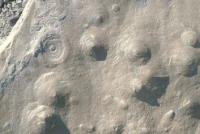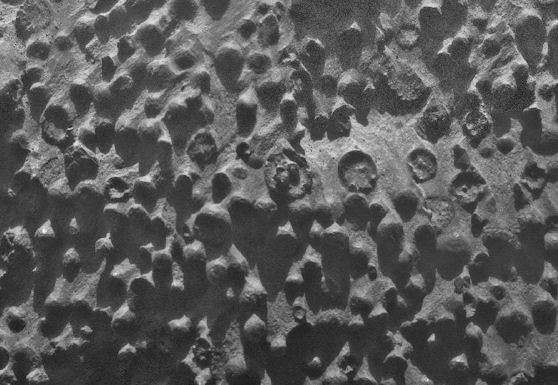It looks like you're using an Ad Blocker.
Please white-list or disable AboveTopSecret.com in your ad-blocking tool.
Thank you.
Some features of ATS will be disabled while you continue to use an ad-blocker.
share:
reply to post by ArMaP
If I'm reading this correctly Methane gas bubbles in sediment can range anywhere between 8.0mm to 0.4mm or maybe smaller , maybe the picture in the OP is of a fossilized sedimentary layer given that its believed that Opportunity is at an ancient Sea bed .
If I'm reading this correctly Methane gas bubbles in sediment can range anywhere between 8.0mm to 0.4mm or maybe smaller , maybe the picture in the OP is of a fossilized sedimentary layer given that its believed that Opportunity is at an ancient Sea bed .
I was struck by the similarity of these spheres on Mars to an image I found of some fossils of very ancient bacterial colonies on Earth. The odd
'rock fins' on which the Martian spheres were found could be similar to stromatolites, fossilized bacterial mats found on Earth. Link to article,
with image, about analogous looking bacterial fossils on Earth:
www.smh.com.au...
reply to post by Ross 54
I must agree with you on this one.
They look very much like the ones in the article you refer to.
I hope that they are something close to what is found on Earth, it would be a fantastic discovery.
I must agree with you on this one.
They look very much like the ones in the article you refer to.
I hope that they are something close to what is found on Earth, it would be a fantastic discovery.
reply to post by gortex
OK, I think I now understand what you mean.
Bubbles inside some sediment that latter solidifies and gets eroded would look like that.
OK, I think I now understand what you mean.
Bubbles inside some sediment that latter solidifies and gets eroded would look like that.
reply to post by elevenaugust
Looks like a really slow boil or heating up, of an extremely thick substance that was inexplicably stopped as if the matter was flash frozen or quickly cooled, mid boil for some reason. Course it could be something that behaves like a thick substance and that might explain the quick cool.
The bubbles look like what you get in a pancake batter when you spread it out. Almost time to flip this!
Then again possibly something meteoric and very hot passed so close that the surface "broiled."
Looks like a really slow boil or heating up, of an extremely thick substance that was inexplicably stopped as if the matter was flash frozen or quickly cooled, mid boil for some reason. Course it could be something that behaves like a thick substance and that might explain the quick cool.
The bubbles look like what you get in a pancake batter when you spread it out. Almost time to flip this!
Then again possibly something meteoric and very hot passed so close that the surface "broiled."
edit on 15-9-2012 by newcovenant because: (no
reason given)
Originally posted by gortex
reply to post by elevenaugust
Well to my untrained eye they do look like fossilized mud bubbles from a thermal hot spring , perfect breeding ground for life I believe
Here's a similar picture from here on Earth .
Size apart, that sounds a good analogy, and there is the obvious difference from the 'blueberries' in that these appear to be almost all partial spheres encased in their surroundings, rather than the 'blueberries' which are not necessarily encased, but are whole spheres resting on varying surface terrain.
To try and give the OP picture some context here is a full picture of the Kirkwood outcrop .
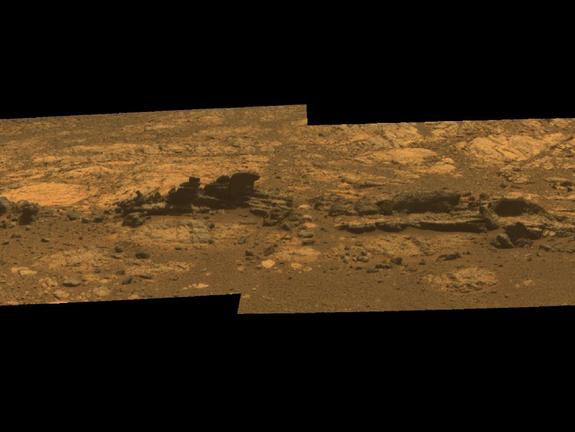
I don't know where on this picture the bubbles ... sorry Spheres .. are located but a closeup inspection of the left side of the outcrop does appear to show some kind of nodules on top

I don't know where on this picture the bubbles ... sorry Spheres .. are located but a closeup inspection of the left side of the outcrop does appear to show some kind of nodules on top
I believe that the spheres are on the odd looking, dark 'rock fins' just left of the center of the image. I doubt they'd be visible in a wide shot
like this, since they're only about 3mm (1/8 inch) in diameter. The image of the spheres was made with a camera fitted with what amounts to a strong
magnifying glass.
The problem I have with this being bubbles formed inside sedimentary (or volcanic) material is this: What is there to preferentially preserve the thin layer of material around the bubbles, when the rest of the 'matrix' is eroded to reveal them?
Of course, bubbles on the flat surface of a rock, caused by great heat, wouldn't be more complete than half-spheres. Some of these Martian spheres clearly are more complete than this.
The problem I have with this being bubbles formed inside sedimentary (or volcanic) material is this: What is there to preferentially preserve the thin layer of material around the bubbles, when the rest of the 'matrix' is eroded to reveal them?
Of course, bubbles on the flat surface of a rock, caused by great heat, wouldn't be more complete than half-spheres. Some of these Martian spheres clearly are more complete than this.
Originally posted by penninja
OH GOD NO, THEY FOUND THE EGGS....NOT THE EGGS NO! SOME OF THEM HAVE HATCHED!
It is only a matter of time now.
30 days to burrow and grow
30 days to absorb enough radiation from the Sun for flight
30 days to reach Earth
10 days to devour us all
The Mayans knew containing them on Mars would not be enough.... but how did they know the date?
easy silly, the incubation period!
Originally posted by elevenaugust
NASA's long-lived rover Opportunity has returned an image of the Martian surface that is puzzling researchers.
Spherical objects concentrated at an outcrop Opportunity reached last week differ in several ways from iron-rich spherules nicknamed "blueberries" the rover found at its landing site in early 2004 and at many other locations to date.
Opportunity is investigating an outcrop called Kirkwood in the Cape York segment of the western rim of Endeavour Crater. The spheres measure as much as one-eighth of an inch (3 millimeters) in diameter. The analysis is still preliminary, but it indicates that these spheres do not have the high iron content of Martian blueberries.
"This is one of the most extraordinary pictures from the whole mission," said Opportunity's principal investigator, Steve Squyres of Cornell University in Ithaca, N.Y. "Kirkwood is chock full of a dense accumulation of these small spherical objects. Of course, we immediately thought of the blueberries, but this is something different. We never have seen such a dense accumulation of spherules in a rock outcrop on Mars."
Opportunity Science team says that these spherules at Kirkwood do not have the iron-rich composition of the blueberries. They also differ in concentration, distribution and structure. Some of the spherules in this image have been partially eroded away, revealing concentric internal structure. They plan to use the rover for further investigation of these spherules to determine what evidence they can provide about ancient Martian environmental conditions.
Source: Science NASA
Very cool, I look forward to hearing what these things are!
The boiling minerals idea seems to hold some merit. Also maybe formed as the atmosphere was depleted in very very hot storms being blown around by the wind of the time before the atmosphere went caput. ...dunno, just speculating.
Originally posted by iforget
From the article they seem to think the popped looking spheres were eroded after fossilization. I see tails on the "tops" of the spheres it looks sortnof like they flowed downwards after they broke the surface of the formation or it's like they seem more a part of the surrounding rock than the blueberries did. It's fascinating
I know it's terrible (and trying to keep it clean here)... kind of like sperm that was ....depositied... to fertilize the "egg of life" and got petrified .... really really big sperm!
Originally posted by gortex
reply to post by ArMaP
If I'm reading this correctly Methane gas bubbles in sediment can range anywhere between 8.0mm to 0.4mm or maybe smaller , maybe the picture in the OP is of a fossilized sedimentary layer given that its believed that Opportunity is at an ancient Sea bed .
Being on a Sea, it could have been just the formation and deposit of minerals, more churning and rolling for the minerals to form "pebbles" of some sort.
ETA: after reading through the rest of the thread, I think the idea of something having been molten makes the most sense. Some lava-type substance where the minerals formed due to different melting points as opposed to the lava but very close, so they "balled up" and erosion over many thousand years has revealed them.
Still have no idea, but that's my favorite speculation for now.
edit on 16-9-2012 by PurpleChiten because: (no reason given)
reply to post by gortex
Judging by this photo:
(click for full size)
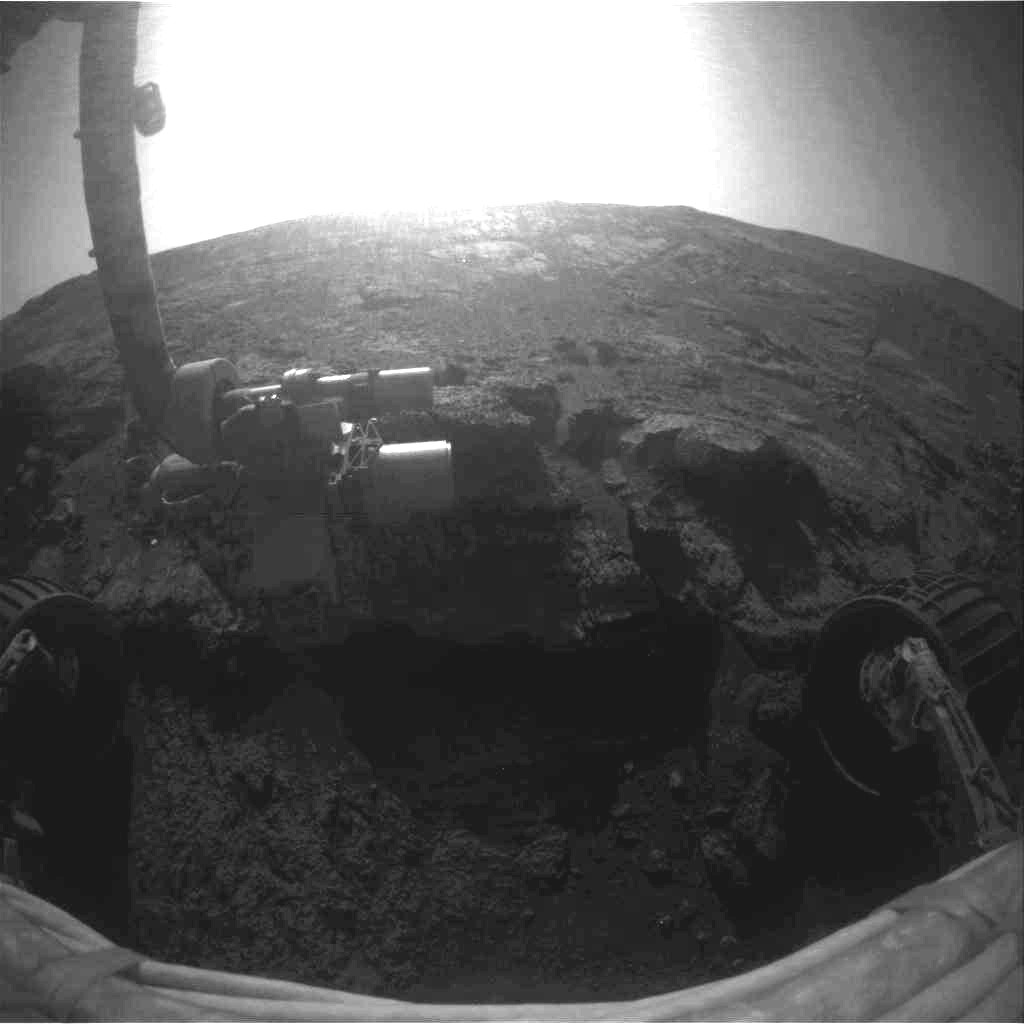
it looks like the area where the spheres are is somewhere in this area:
(click for full size)
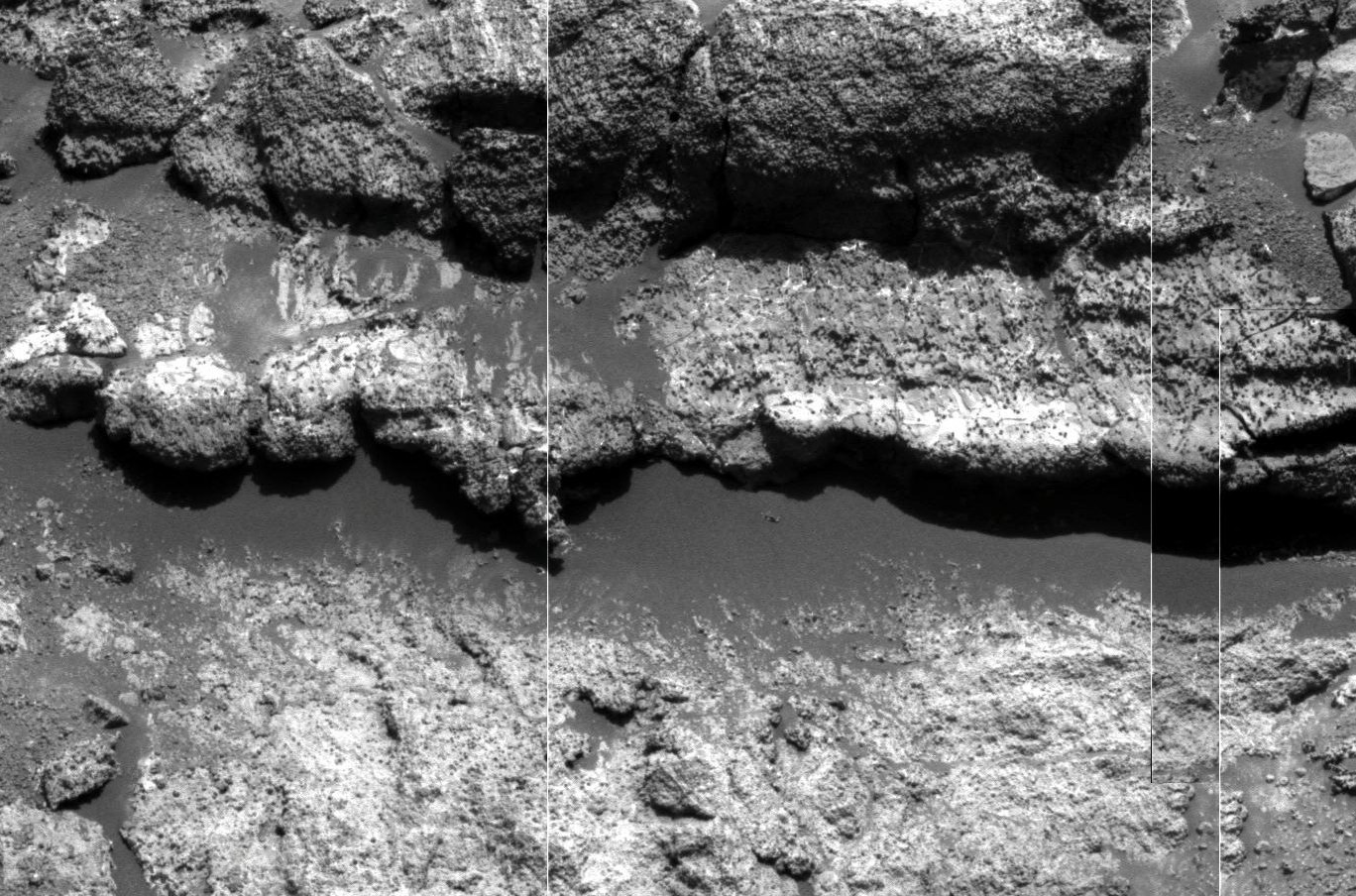
(the above image was made with 3 or 4 images from the panoramic camera from Sol 6062, and I didn't worry about making it look good )
Edit: a false colour version of that area. In this version the blues are exaggerated, but it gives us an idea of the difference in colours of the different areas.
(click for full size)

Judging by this photo:
(click for full size)

it looks like the area where the spheres are is somewhere in this area:
(click for full size)

(the above image was made with 3 or 4 images from the panoramic camera from Sol 6062, and I didn't worry about making it look good )
Edit: a false colour version of that area. In this version the blues are exaggerated, but it gives us an idea of the difference in colours of the different areas.
(click for full size)

edit on 16/9/2012 by ArMaP because: (no reason given)
My guess would be that in certain environmental conditions, some more dense or glassy bits of rock would tend to accumulate more CO2 condensation than
others, it would get dust on it, and that dust would settle back down onto the rock after the condensation evaporated. Repeat the process over a long
period of time, and with nothing around to disturb it, I imagine it would accumulate and form these kinds of spheres.
I'm no expert, though.
I'm no expert, though.
reply to post by ArMaP
Nice work ArMaP
I've had a scan over the images you posted but can't really see a likely candidate for what we see in the OP image , I would love to see some higher res images of the site but I guess we got what we got and we should be grateful for that .
Maybe over the course of the next few weeks better images will be released and an exiting theory will be put forward , until then we can but speculate
Nice work ArMaP
I've had a scan over the images you posted but can't really see a likely candidate for what we see in the OP image , I would love to see some higher res images of the site but I guess we got what we got and we should be grateful for that .
Maybe over the course of the next few weeks better images will be released and an exiting theory will be put forward , until then we can but speculate
reply to post by penninja
I agree..
This 'disclosure' will take place throught 2012 and through 2013, as information about what the rover is finding is shared with the public.
There may not be a 'Breaking News' message about life on Mars on CNN; the informed public will accept it slowly but surely until it is common knowledge, the same that racial harmony occured through the decades.
I agree..
This 'disclosure' will take place throught 2012 and through 2013, as information about what the rover is finding is shared with the public.
There may not be a 'Breaking News' message about life on Mars on CNN; the informed public will accept it slowly but surely until it is common knowledge, the same that racial harmony occured through the decades.
new topics
-
Big Storms
Fragile Earth: 1 hours ago -
Where should Trump hold his next rally
2024 Elections: 3 hours ago -
Shocking Number of Voters are Open to Committing Election Fraud
US Political Madness: 4 hours ago -
Gov Kristi Noem Shot and Killed "Less Than Worthless Dog" and a 'Smelly Goat
2024 Elections: 5 hours ago -
Falkville Robot-Man
Aliens and UFOs: 5 hours ago -
James O’Keefe: I have evidence that exposes the CIA, and it’s on camera.
Whistle Blowers and Leaked Documents: 6 hours ago -
Australian PM says the quiet part out loud - "free speech is a threat to democratic dicourse"...?!
New World Order: 7 hours ago -
Ireland VS Globalists
Social Issues and Civil Unrest: 7 hours ago -
Biden "Happy To Debate Trump"
2024 Elections: 8 hours ago -
RAAF airbase in Roswell, New Mexico is on fire
Aliens and UFOs: 8 hours ago
top topics
-
A Warning to America: 25 Ways the US is Being Destroyed
New World Order: 17 hours ago, 21 flags -
Blast from the past: ATS Review Podcast, 2006: With All Three Amigos
Member PODcasts: 10 hours ago, 13 flags -
James O’Keefe: I have evidence that exposes the CIA, and it’s on camera.
Whistle Blowers and Leaked Documents: 6 hours ago, 13 flags -
Biden "Happy To Debate Trump"
2024 Elections: 8 hours ago, 12 flags -
Australian PM says the quiet part out loud - "free speech is a threat to democratic dicourse"...?!
New World Order: 7 hours ago, 12 flags -
Mike Pinder The Moody Blues R.I.P.
Music: 10 hours ago, 8 flags -
What is the white pill?
Philosophy and Metaphysics: 9 hours ago, 6 flags -
Shocking Number of Voters are Open to Committing Election Fraud
US Political Madness: 4 hours ago, 5 flags -
Ireland VS Globalists
Social Issues and Civil Unrest: 7 hours ago, 5 flags -
RAAF airbase in Roswell, New Mexico is on fire
Aliens and UFOs: 8 hours ago, 5 flags
active topics
-
"We're All Hamas" Heard at Columbia University Protests
Social Issues and Civil Unrest • 293 • : marg6043 -
So this is what Hamas considers 'freedom fighting' ...
War On Terrorism • 267 • : NorthOS -
President BIDEN Vows to Make Americans Pay More Federal Taxes in 2025 - Political Suicide.
2024 Elections • 146 • : Zanti Misfit -
Definitive 9.11 Pentagon EVIDENCE.
9/11 Conspiracies • 427 • : Zanti Misfit -
Big Storms
Fragile Earth • 8 • : charlest2 -
SHORT STORY WRITERS CONTEST -- April 2024 -- TIME -- TIME2024
Short Stories • 24 • : argentus -
Gov Kristi Noem Shot and Killed "Less Than Worthless Dog" and a 'Smelly Goat
2024 Elections • 35 • : nugget1 -
Ireland VS Globalists
Social Issues and Civil Unrest • 7 • : boatguy12 -
I am beholden to my truth, of which I share with you now.
Dreams & Predictions • 24 • : BrotherKinsMan -
Starburst galaxy M82 - Webb Vs Hubble
Space Exploration • 11 • : Arbitrageur

